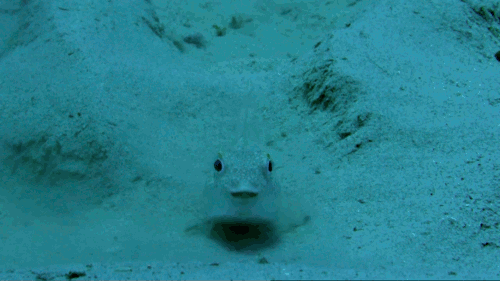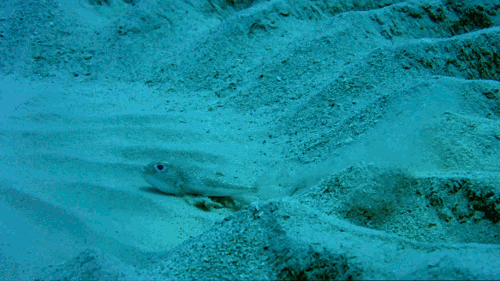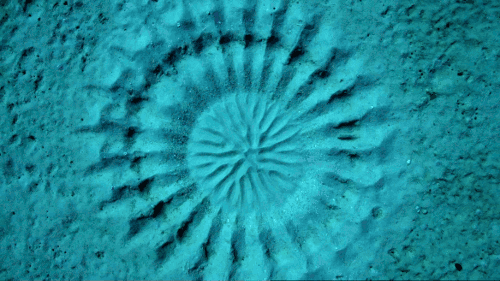Hold A Buoyant Sphere Like A Ping Pong Ball Underwater And Let It Go, And You’ll Find That The Ball

Hold a buoyant sphere like a ping pong ball underwater and let it go, and you’ll find that the ball pops up out of the water. Intuitively, you would think that letting the ball go from a lower depth would make it pop up higher – after all, it has a greater distance to accelerate over, right? But it turns out that the highest jumps comes from balls that rise the shortest distance. When released at greater depths, the buoyant sphere follows a path that swerves from side to side. This oscillating path is the result of vortices being shed off the ball, first on one side and then the other. (Image and research credit: T. Truscott et al.)
More Posts from Hannahhaifisch and Others

Quantum tunnelling
Tunneling is a quantum mechanical effect. A tunneling current occurs when electrons move through a barrier that they classically shouldn’t be able to move through. In classical terms, if you don’t have enough energy to move “over” a barrier, you won’t. However, in the quantum mechanical world, electrons have wavelike properties. These waves don’t end abruptly at a wall or barrier, but taper off quickly. If the barrier is thin enough, the probability function may extend into the next region, through the barrier! Because of the small probability of an electron being on the other side of the barrier, given enough electrons, some will indeed move through and appear on the other side. When an electron moves through the barrier in this fashion, it is called tunneling.

Quantum mechanics tells us that electrons have both wave and particle-like properties. Tunneling is an effect of the wavelike nature.

The top image shows us that when an electron (the wave) hits a barrier, the wave doesn’t abruptly end, but tapers off very quickly - exponentially. For a thick barrier, the wave doesn’t get past.
The bottom image shows the scenario if the barrier is quite thin (about a nanometer). Part of the wave does get through and therefore some electrons may appear on the other side of the barrier.
Because of the sharp decay of the probability function through the barrier, the number of electrons that will actually tunnel is very dependent upon the thickness of the barrier. The current through the barrier drops off exponentially with the barrier thickness
Source: nanoscience.com | Images: x | x | x

38.8256322, 33.1437783










Interlocked Coins Form Complex Geometric Sculptures

69.6027062, -25.5389832



A small Japanese puffer fish is the creator of one of the most spectacular animal-made structures. To impress the female puffer fish, the male labors 24 hours a day for a week to create a pattern in the sand. If the female finds his work satisfactory, she allows him to fertilize her eggs. She then lays them in the middle of the circle, leaving the male to guard the eggs alone.
Life Story (2014)

Swirling swarms of bacteria offer insights on turbulence
In the bacterial world, as in the larger one, beauty can be fleeting. When swimming together with just the right amount of vigor, masses of bacterial cells produce whirling, hypnotic patterns. Too much vigor, however, and they descend into chaotic turbulence.
A team of physicists led by Rockefeller University fellow Tyler Shendruk recently detected a telling mathematical signature inscribed in that disintegration from order to chaos. Their discovery, described May 16 in Nature Communications, provides the first concrete link between turbulence in a biological system and within the larger physical world, where it is best known for buffeting planes and boats.
Amin Doostmohammadi, Tyler N. Shendruk, Kristian Thijssen, Julia M. Yeomans. Onset of meso-scale turbulence in active nematics. Nature Communications, 2017; 8: 15326 DOI: 10.1038/NCOMMS15326
When swimming together, bacteria produce swirling patterns that can disintegrate into turbulence as they speed up. Credit: Kristian Thijssen

0086


Native Gold with White Quartz
Eagle’s Nest Mine, Placer County, California
-
 techjum reblogged this · 4 years ago
techjum reblogged this · 4 years ago -
 cerenecerenity-blog liked this · 6 years ago
cerenecerenity-blog liked this · 6 years ago -
 typicalspoon liked this · 6 years ago
typicalspoon liked this · 6 years ago -
 xivblack liked this · 6 years ago
xivblack liked this · 6 years ago -
 neutralfem liked this · 6 years ago
neutralfem liked this · 6 years ago -
 rat-daddy reblogged this · 6 years ago
rat-daddy reblogged this · 6 years ago -
 rat-daddy liked this · 6 years ago
rat-daddy liked this · 6 years ago -
 laurellynnleake reblogged this · 6 years ago
laurellynnleake reblogged this · 6 years ago -
 100percentreasontoremembertheurl liked this · 7 years ago
100percentreasontoremembertheurl liked this · 7 years ago -
 whalesandcraftbeers reblogged this · 8 years ago
whalesandcraftbeers reblogged this · 8 years ago -
 perhapsihavesucceeded reblogged this · 8 years ago
perhapsihavesucceeded reblogged this · 8 years ago -
 stefagreader reblogged this · 8 years ago
stefagreader reblogged this · 8 years ago -
 rezby reblogged this · 8 years ago
rezby reblogged this · 8 years ago -
 didyouseethisthing reblogged this · 8 years ago
didyouseethisthing reblogged this · 8 years ago -
 edwardcucken reblogged this · 8 years ago
edwardcucken reblogged this · 8 years ago -
 perhapsihavesucceeded reblogged this · 8 years ago
perhapsihavesucceeded reblogged this · 8 years ago -
 amaralikecamera reblogged this · 8 years ago
amaralikecamera reblogged this · 8 years ago -
 bradkey reblogged this · 8 years ago
bradkey reblogged this · 8 years ago -
 neon-ceiling reblogged this · 8 years ago
neon-ceiling reblogged this · 8 years ago -
 neon-ceiling liked this · 8 years ago
neon-ceiling liked this · 8 years ago -
 giancarloguillermo reblogged this · 8 years ago
giancarloguillermo reblogged this · 8 years ago -
 mrcorystraw reblogged this · 8 years ago
mrcorystraw reblogged this · 8 years ago -
 siriuslycrazy reblogged this · 8 years ago
siriuslycrazy reblogged this · 8 years ago -
 diabolicalnerd reblogged this · 8 years ago
diabolicalnerd reblogged this · 8 years ago -
 persistenceoffantasy liked this · 8 years ago
persistenceoffantasy liked this · 8 years ago -
 thingsmydadmightlike-blog reblogged this · 8 years ago
thingsmydadmightlike-blog reblogged this · 8 years ago -
 24hourcharleston liked this · 8 years ago
24hourcharleston liked this · 8 years ago -
 drala-fa reblogged this · 8 years ago
drala-fa reblogged this · 8 years ago -
 drala-fa liked this · 8 years ago
drala-fa liked this · 8 years ago -
 windowlicker liked this · 8 years ago
windowlicker liked this · 8 years ago -
 ellimist reblogged this · 8 years ago
ellimist reblogged this · 8 years ago -
 action-exclamation reblogged this · 8 years ago
action-exclamation reblogged this · 8 years ago -
 action-exclamation liked this · 8 years ago
action-exclamation liked this · 8 years ago -
 osanzo reblogged this · 8 years ago
osanzo reblogged this · 8 years ago -
 osanzo liked this · 8 years ago
osanzo liked this · 8 years ago -
 promptoargentbutt-blog reblogged this · 8 years ago
promptoargentbutt-blog reblogged this · 8 years ago -
 totalmoron liked this · 8 years ago
totalmoron liked this · 8 years ago -
 flashbeads reblogged this · 8 years ago
flashbeads reblogged this · 8 years ago -
 gracefully-gauche liked this · 8 years ago
gracefully-gauche liked this · 8 years ago -
 chillgamesh-the-swing reblogged this · 8 years ago
chillgamesh-the-swing reblogged this · 8 years ago -
 songbird-with-a-sore-throat reblogged this · 8 years ago
songbird-with-a-sore-throat reblogged this · 8 years ago